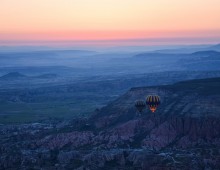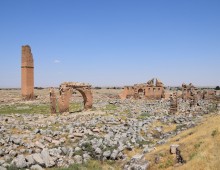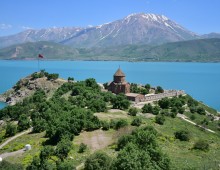“You should go to Mardin!” Mardin? This name didn’t ring a bell when we heard it for the first time. It was Marie-Eva who told us about it when we met her in Yazd, Iran. She was travelling with her two girlfriends and had been living in Turkey. But she never had the chance to go to Mardin. “You really should go there” she said again. “But check the safety before. It’s near Syria”. We found that the safety level of the region was ok. So at that moment, “near Syria” meant for us that there would not be any mass tourism. Hence that was the perfect place to discover.
The road from Van to Mardin in Southeast Turkey was beautiful. We crossed mountains, green valleys, and mountains again. We went through the little village of Hasankeyf with its troglodyte houses. This old village is threatened to be flooded because of the construction of a dam. We didn’t have the chance to take pictures as our minibus drove fast on the winding road. The driving habits of Turkish bus drivers was not better than the Iranian’s ones… Finally we saw Mardin, perched on the top of a hill dominating the endless plains of Mesopotamia. What a breathtaking view!
Strategically located, Mardin was successively inhabited by Christians, Arabs, Mongols… a real melting pot of religions and civilizations. In 1516, it is part of the Ottoman Empire. At the end of the 19th century, half of its population is Christian. During the First World War, its Christian population is persecuted, especially 20 000 people are killed or deported in the Assyrian Genocide and Armenian Genocide.
But today the historical side of Mardin remains through its Artuqid architecture (from the name of the dynasty that ruled the region in the 12th century). When walking in the old city, we could see beautiful decorations on stone houses, such as sculpted portals and doors. The minarets were also stunning, yellow under the sunlight. We had a great pleasure walking in the city, getting lost in the tiny streets, discovering beautiful sculptures at every corner, and moreover enjoying views on the plains of Mesopotamia below. Except for the main road, the old city is pedestrian and to collect the garbage, a man goes through the streets with his donkey.
When the sun set, we used to go eat at our favorite restaurant, Seyr-i Merdin, with its quiet terrace overlooking the valley. We would eat delicious Zirh Kebab and enjoy complimentary tea. We had also found a great place to stay: Dara Konagi, a charming and ancient house with rooms as if you were back in the times of the Silk Road. We loved it! We were the only Western tourists in the streets, and I feel there were not a lot of Turkish tourists either. So people would stare at us until we say with a smile “Merhaba” which means Hello in Turkish. They would then answer with a big smile and put their right hand on their heart. In Turkey, people look more reserved than in Iran. But once the ice is broken, they are also such charming people.
We stayed a few days in Mardin and we wished we could have stayed more because of its peaceful atmosphere. Our immersion in Mesopotamia had made us want to discover more about this most ancient inhabited part of the world and the region of most Biblical stories. So for our next destination, we didn’t think too much. We were only a few hours away from Urfa (or Sanliurfa) which is renowned for being the place of birth of Prophet Abraham (at least that’s what Muslims believe, Christians believe it’s somewhere else). We couldn’t miss it!



